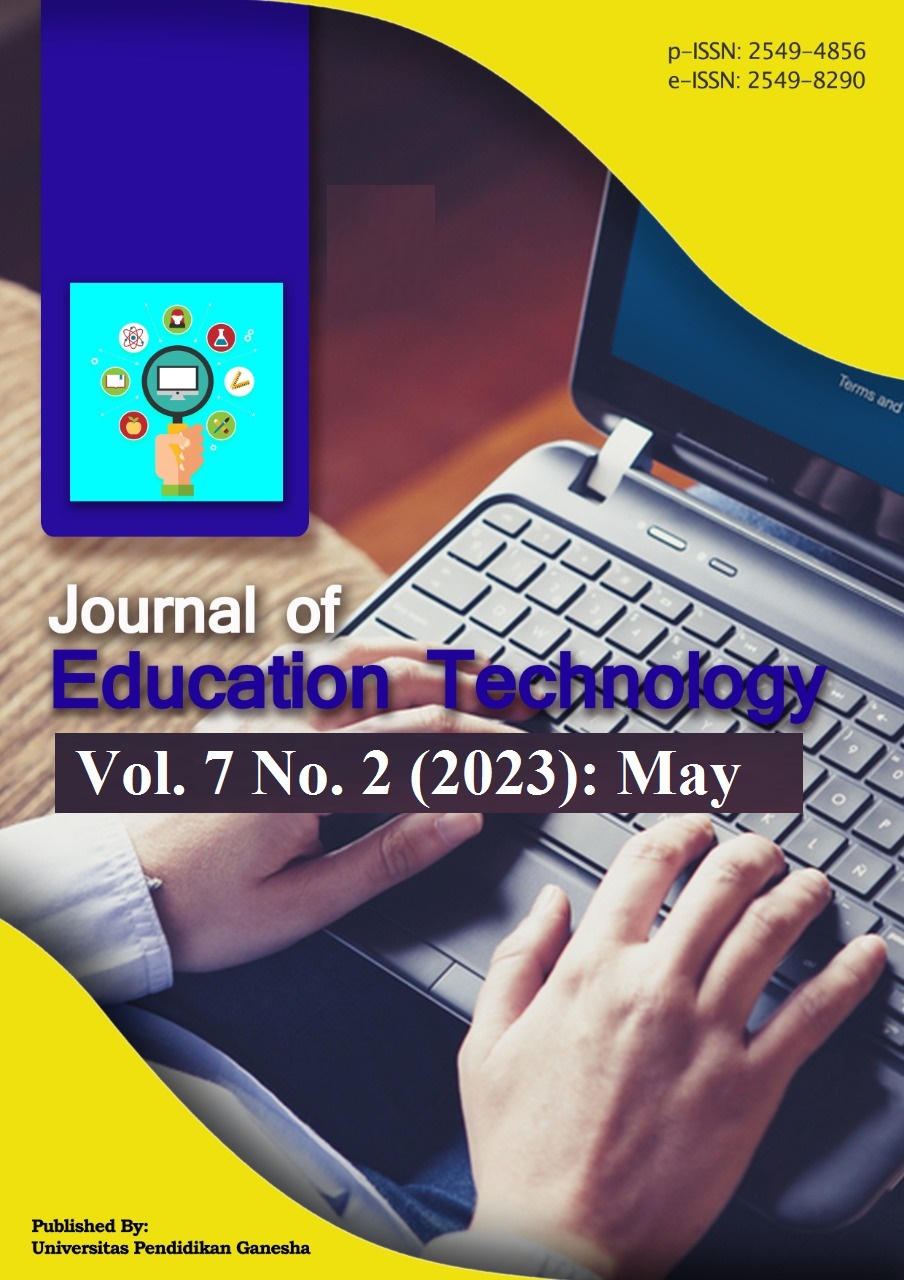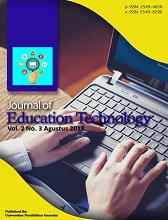Improving Student Balinese Language Learning Outcomes through Interactive Animated Video Based on a Contextual Method
DOI:
https://doi.org/10.23887/jet.v7i2.64151Keywords:
Animated Video, Interactive, ContextualAbstract
The Balinese language's position as a mother tongue or regional language contributes to establishing the identity of its people. However, the use of Balinese is decreasing over time, and the quantity of speakers is decreasing. This study aims to develop interactive animated video media based on contextual method to improve students’ Balinese Language learning outcomes. Hannafin and Peck's model which comprises three processes (needs analysis, design, development, and execution) was employed in this development study project. The information was gathered using tests, questionnaires, observations, documentaries, and surveys. Data analysis techniques include the t-test, inferential statistical analysis, and quantitative descriptive analysis. Three students participated in the solo trials, nine in the small group trials, and sixteen in the outdoor tests of this study. Experts in learning media, design, and content served as the subjects. The results of the individual trial, small group trial, field trial, learning content expert test, learning design expert test, learning media expert test, and the learning media expert test were all excellent, with percentage scores of 96.66%, 94.66%, 90.22%, and 98.125%, were used to determine the validity of the interactive animated video media. The t-test illustrates the effectiveness of interactive animated video media by showing significant variations in student learning outcomes between the pre-and post-use media. Since the post-test results of the children are above the National Minimum Completeness Criteria, it is clear that interactive animated video media is an effective tool to assist Balinese Language learning process.
References
Abduh, M., & Istiqomah, A. (2021). Analisis Muatan Hots dan Kecakapan Abad 21 pada Buku Siswa Kelas V Tema Ekosistem di Sekolah Dasar. Jurnal Basicedu, 5(4), 2069–2081. https://doi.org/10.31004/basicedu.v5i4.1124.
Agustini, K., Santyadiputra, G. S., & Sugihartini, N. (2020). Visualizing the stages of the educational research methodology into animation infographics for vocational students. Jurnal Pendidikan Vokasi, 9(3), 317–327. https://doi.org/10.21831/jpv.v9i3.22017.
Alfiansyah, M. F., Adi, E. P., & Soepriyanto, Y. (2022). Pengembangan Multimedia Interaktif Ipa Dengan Fitur Feedback Untuk Siswa Kelas Viii. JKTP: Jurnal Kajian Teknologi Pendidikan, 5(1), 22–31. https://doi.org/10.17977/um038v5i12022p022.
Ariani, N. K., & Ujianti, P. R. (2021). Media Video Animasi untuk Meningkatkan Listening Skill Anak Usia Dini. Jurnal Pendidikan Anak Usia Dini Undiksha, 9(1), 43. https://doi.org/10.23887/paud.v9i1.35690.
Braad, E., Degens, N., Barendregt, W., & IJsselsteijn, W. (2022). Improving metacognition through self-explication in a digital self-regulated learning tool. Educational Technology Research and Development, 70(6), 2063–2090. https://doi.org/10.1007/s11423-022-10156-2.
Cavanagh, T. M., & Kiersch, C. (2022). Using commonly-available technologies to create online multimedia lessons through the application of the Cognitive Theory of Multimedia Learning. Educational Technology Research and Development, 0123456789. https://doi.org/10.1007/s11423-022-10181-1.
Chen, L., Tang, X., Liu, Q., & Zhang, X. (2023). Heliyon Self-directed learning : Alternative for traditional classroom learning in undergraduate ophthalmic education during the COVID-19 pandemic in China. Heliyon, 9(5), e15632. https://doi.org/10.1016/j.heliyon.2023.e15632.
Cubukcu, C., Murat, K. C., & Yigit, O. (2020). “Mobile Game Development for Children with Down Syndrome.” International Journal of Interactive Mobile Technologies, 14(20), 174–83,. https://doi.org/10.3991/IJIM.V14I20.16573.
Daryanes, F., Darmadi, D., Fikri, K., & Sayuti, I. (2023). Heliyon The development of articulate storyline interactive learning media based on case methods to train student ’ s problem-solving ability. Heliyon, 9(4), e15082. https://doi.org/10.1016/j.heliyon.2023.e15082.
Dasmo, Lestari, A. P., & Alamsyah, M. (2020). Peningkatan hasil belajar fisika melalui penerapan media pembelajaran interaktif berbasis ispring suite 9. Prosiding Seminar Nasional Sains, 1(1), 99–102. http://www.proceeding.unindra.ac.id/index.php/sinasis/article/view/3979.
Dewi, D. N. D. R. (2020). Implementing Language Policy at School: The Case of Balinese Language. LINGUA SCIENTA: Journal of Foreign Language Teaching and Linguistics, 18(2), 115–134. https://repo.undiksha.ac.id/id/eprint/1902.
Elmunsyah, H., Hidayat, W. N., & Asfani, K. (2019). Interactive learning media innovation: utilization of augmented reality and pop-up book to improve user’s learning autonomy. Journal of Physics: Conference Series, 1193, 012031. https://doi.org/10.1088/1742-6596/1193/1/012031.
Fatimah, A. S., & Santiana, S. (2017). Teaching in 21St Century: Students-Teachers’ Perceptions of Technology Use in the Classroom. Script Journal: Journal of Linguistic and English Teaching, 2(2), 125. https://doi.org/10.24903/sj.v2i2.132.
Firmadani, F. (2020). Media Pembelajaran Berbasis Teknologi Sebagai Inovasi Pembelajaran Era Revolusi Industri 4.0. KoPeN: Konferensi Pendidikan Nasional, 2(1), 93–97. https://ejurnal.mercubuanayogya.ac.id/index.php/prosiding_kopen/article/download/1084/660.
Garcia, V., Conesa, J., & Perez, A. (2022). Videos with Hands : an Analysis of Usage and Interactions of Undergraduate Science Students for Acquiring Physics Knowledge. 442–460. https://doi.org/10.1007/s10956-022-09966-z.
Giri, I. M. A. (2017). Pelestarian Bahasa, Aksara, dan Sastra Bali Melalui Pengoptimalan Tripusat Pendidikan. Purwadita, 1(1), 27–32. https://stahnmpukuturan.ac.id/jurnal/index.php/Purwadita/article/download/6/5.
Hannafin, & Peck. (1988). The Design Development and Evaluation of Instructional Software. Macmillan Publishing Company.
Hapsari, A. S., Hanif, M., Gunarhadi, & Roemintoyo. (2019). Motion Graphic Animation Videos to Improve the Learning Outcomes of Elementary School Students. European Journal of Educational Research, 8(4), 1245–1255. https://doi.org/10.12973/eu-jer.8.4.1245.
Hayat, M. S., Rustaman, N. Y., Rahmat, A., & Redjeki, S. (2019). Perbedaan Hasil Belajar Siswa yang Menggunakan Multimedia Interaktif dengan Buku Teks Dalam Pembelajaran Biologi di SMA. Jurnal Mangifera Edu, 4(1), 62–71. https://doi.org/10.31943/mangiferaedu.v4i1.42.
Hidayati, N. F. (2022). Upaya Meningkatkan Hasil Belajar Muatan Pelajaran IPA Kelas VI MI Al Firdaus Kota Bekasi Pada Konsep Perkembangbiakan Vegetatif Alami Tumbuhan Melalui Pendekatan Kontekstual (Contextual Teaching And Learning). Serambi Akademica, 10(11), 1071–1081. https://doi.org/10.32672/jsa.v10i11.5503.
Ibrahem, U. M., & Alamro, A. R. (2020). Effects of Infographics on Developing Computer Knowledge, Skills and Achievement Motivation among Hail University Students. International Journal of Instruction, 14(1), 907–926. https://doi.org/10.29333/IJI.2021.14154A.
Khaitova, N. F. (2021). History of Gamification and Its Role in the Educational Process. International Journal of Multicultural and Multireligious Understanding, 8(5), 212. https://doi.org/10.18415/ijmmu.v8i5.2640.
Kumar, V., & Nanda, P. (2019). Social media in higher education: A framework for continuous engagement. International Journal of Information and Communication Technology Education (IJICTE), 1, 5(1), 97–108. https://doi.org/10.4018/IJICTE.2019010107.
Malini, N. N. S., Laksminy, L. P., & Sulibra, N. K. N. (2017). The System of Balinese Language Inheritance at International Tourism Destinations in Bali. Udayana Journal of Social Sciences and Humanities, 1(1), 63. https://doi.org/10.24843/ujossh.2017.v01.i01.p10.
Miles, M. B., Huberman, A. M., & Saldaña, J. (1994). Qualitative Data Analysis (3th ed.). Sage.
Mulyawan, I. W. (2021). Maintaining and revitalising Balinese language in public space: A controversial language planning regulation. Indonesia and the Malay World, 49(145), 481–495. https://doi.org/10.1080/13639811.2021.1910356.
Nadzif, M., Irhasyuarna, Y., & Sauqina, S. (2022). Pengembangan Media Pembelajaran Interaktif IPA Berbasis Articulate Storyline Pada Materi Sistem Tata Surya SMP. JUPEIS : Jurnal Pendidikan Dan Ilmu Sosial, 1(3), 17–27. https://doi.org/10.55784/jupeis.vol1.iss3.69.
Novita, R. R., & Jumadi. (2022). Students’ Conceptual Understanding and Self-Directed Learning on Blended Learning. Journal of Education Technology, 6(4), 617–624. https://doi.org/10.23887/jet.v6i4.49229.
Nugroho, I. A., & Surjono, H. D. (2019). Pengembangan multimedia pembelajaran interaktif berbasis video materi sikap cinta tanah air dan peduli lingkungan. Jurnal Inovasi Teknologi Pendidikan. https://doi.org/10.21831/jitp.v6i1.15911.
Purba, R. A., Rofiki, I., Purba, S., Purba, P. B., Bachtiar, E., Iskandar, A., Febrianty, F., Yanti, Y., Simarmata, J., & Chamidah, D. (2020). Pengantar Media Pembelajaran. Yayasan Kita Menulis.
Purwati, P. (2021). Implementasi Media Video Animasi Interaktif Secara Daring Untuk Meningkatkan Hasil Belajar Dan Keaktifan Siswa Kelas IV SDN Tulung 03 Pada Tema 8 Semester 2 Tahun Pelajaran 2020/2021. Educatif Journal of Education Research, 3(2), 124–134. https://doi.org/10.36654/educatif.v3i2.76.
Putri, I. G. A. V. W., & Nurita, W. (2021). Critical condition in Balinese lexicon extinction. Journal of Language and Linguistic Studies, 17(4), 1773–1786. https://doi.org/10.52462/jlls.129.
Rokhim, D. A., Widarti, H. R., & Fajaroh, F. (2020). Pengembangan Bahan Belajar Flipbook pada Materi Redoks dan Elektrokimia Berbasis Pendekatan STEM-PjBL Berbantuan Video Pembelajaran. Kwangsan: Jurnal Teknologi Pendidikan, 8(2), 234–250. https://doi.org/http://doi.org/10.31800/jtp.kw.v8n2.p234--250 PENGEMBANGAN.
Setyorini, R., Saddhono, K., Ermanto, Wildan, M., & Kirom, S. (2019). The Effort of Implementing of the Big Book as A Media to Improve the Intelligence of Linguistic Verbals for Early Childhood. Journal of Physics: Conference Series, 1339(1). https://doi.org/10.1088/1742-6596/1339/1/012087.
Shebastian, I. G. R. ., Suyasa, I. M. S., & Arta, P. . (2020). Pengembangan Media Pembelajaran Interaktif “ Pengenalan Hewan Dan Tumbuhan ” Pada Mata Metode Gamefikasi Untuk Siswa Kelas Ii Di Sekolah Dasar. Karmapati, 9(1), 8–20. https://doi.org/10.23887/karmapati.v9i1.23270.
Suandi, I. N., & Mudana, I. W. (2020). Upaya Pelestarian Bahasa dan Budaya Bali Melalui Pengembangan Kamus Seni Tari Bali. Jurnal Komunikasi Hukum (JKH), 6(1), 335–353. https://doi.org/10.23887/jkh.v6i1.24659.
Sudarma, I. K, D. (2015). Desain Pesan Kajian Analitis Desain Visual Teks dan Image. Yogyakarta: Graha Ilmu.
Tani, M., Manuguerra, M., & Khan, S. (2022). Can videos affect learning outcomes? Evidence from an actual learning environment. Educational Technology Research and Development, 70(5), 1675–1693. https://doi.org/10.1007/s11423-022-10147-3.
Werdiningsih, T., Triyono, M. B., & Majid, N. W. A. (2019). Interactive multimedia learning based on mobile learning for computer assembling subject using the principle of multimedia learning (Mayer). International Journal of Advanced Science and Technology, 28(16), 711–719. https://www.researchgate.net/profile/Nuur-Wachid-Abdul-Majid/publication/342158818_Interactive_Multimedia_Learning_based_on_Mobile_Learning_for_Computer_Assembling_Subject_using_the_Principle_of_Multimedia_Learning_Mayer/links/5ee5a3c6299bf1faac55b70e/Int.
Winaldi, Roza, Y., & Maimunah. (2019). Android Pada Materi Perbandingan Trigonometri. Jurnal Cendekia: Jurnal Pendidikan Matematika, 03(02), 513–524. https://doi.org/10.31004/cendekia.v3i2.144.
Zhang, Z., Li, H., & Zhou, J. (2023). Heliyon Teaching with social context in instructional video facilitates second language vocabulary learning. Heliyon, 9(3), e14540. https://doi.org/10.1016/j.heliyon.2023.e14540.
Downloads
Published
How to Cite
Issue
Section
License
Copyright (c) 2023 Ni Putu Listya Devi

This work is licensed under a Creative Commons Attribution-ShareAlike 4.0 International License.
Authors who publish with the Journal of Education Technology agree to the following terms:
- Authors retain copyright and grant the journal the right of first publication with the work simultaneously licensed under a Creative Commons Attribution License (CC BY-SA 4.0) that allows others to share the work with an acknowledgment of the work's authorship and initial publication in this journal.
- Authors are able to enter into separate, additional contractual arrangements for the non-exclusive distribution of the journal's published version of the work (e.g., post it to an institutional repository or publish it in a book), with an acknowledgment of its initial publication in this journal.
- Authors are permitted and encouraged to post their work online (e.g., in institutional repositories or on their website) prior to and during the submission process, as it can lead to productive exchanges, as well as earlier and greater citation of published work. (See The Effect of Open Access)


















